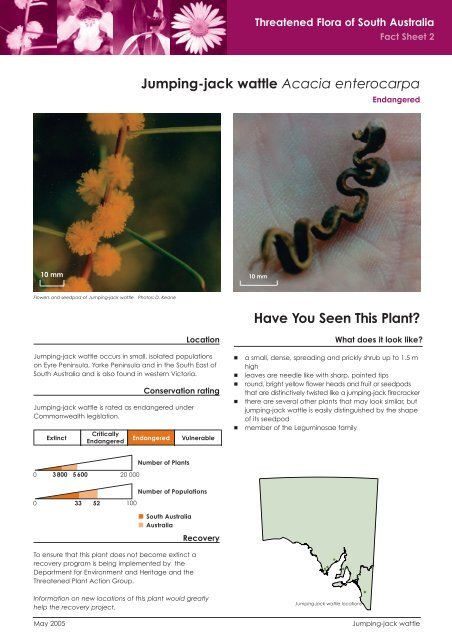Fact sheet 2, Jumping-jack Wattle - Eyre Peninsula Natural ...
Fact sheet 2, Jumping-jack Wattle - Eyre Peninsula Natural ...
Fact sheet 2, Jumping-jack Wattle - Eyre Peninsula Natural ...
- No tags were found...
Create successful ePaper yourself
Turn your PDF publications into a flip-book with our unique Google optimized e-Paper software.
Threatened Flora of South Australia<strong>Fact</strong> Sheet 2<strong>Jumping</strong>-<strong>jack</strong> wattle Acacia enterocarpaEndangered10 mm 10 mmFlowers and seedpod of <strong>Jumping</strong>-<strong>jack</strong> wattle Photos: D. KeaneHave You Seen This Plant?Location<strong>Jumping</strong>-<strong>jack</strong> wattle occurs in small, isolated populationson <strong>Eyre</strong> <strong>Peninsula</strong>, Yorke <strong>Peninsula</strong> and in the South East ofSouth Australia and is also found in western Victoria.Conservation rating<strong>Jumping</strong>-<strong>jack</strong> wattle is rated as endangered underCommonwealth legislation.ExtinctCriticallyEndangeredEndangeredVulnerableWhat does it look like?a small, dense, spreading and prickly shrub up to 1.5 mhighleaves are needle like with sharp, pointed tipsround, bright yellow flower heads and fruit or seedpodsthat are distinctively twisted like a jumping-<strong>jack</strong> firecrackerthere are several other plants that may look similar, butjumping-<strong>jack</strong> wattle is easily distinguished by the shapeof its seedpodmember of the Leguminosae familyNumber of Plants038005 60020 000Number of Populations033 52100South AustraliaAustraliaRecoveryTo ensure that this plant does not become extinct arecovery program is being implemented by theDepartment for Environment and Heritage and theThreatened Plant Action Group.Information on new locations of this plant would greatlyhelp the recovery project.May 2005<strong>Jumping</strong>-<strong>jack</strong> wattle locations<strong>Jumping</strong>-<strong>jack</strong> wattle
<strong>Jumping</strong>-<strong>jack</strong> wattle (in flower) Photo: K. Smith<strong>Jumping</strong>-<strong>jack</strong> wattle in roadside vegetation Photo: A. BondWhere does it occur?<strong>Jumping</strong>-<strong>jack</strong> wattle occurs in small, isolated populationson <strong>Eyre</strong> <strong>Peninsula</strong>, Yorke <strong>Peninsula</strong> and in the South East ofSouth Australia and is also found in western Victoria. Itoccurs in many different habitats, and is commonly foundon fertile soil.ThreatsSpecies that are endangeredí are often living in less thanideal situations, where various processes threaten theirability to survive and reproduce.Serious threats to these plants include:Actions: Protect roadside plants with roadside markers Rabbit control Weed control Study effects of fire on regeneration and disease control Propagate and plant seedlings in existing populations(seedlings are planted at the site that seed wascollected from) Monitor growth and survival Maintain seed in long term storage Search for further populationsHow you can helpHelping to save threatened species is something thateveryone can become involved in. Report any new sightings of jumping-<strong>jack</strong> wattle to thecontacts listed on this page. Protect any native plants and habitat on your propertyfrom grazing, clearance and weeds. Join Threatened Plant Action Group or your localLandcare, Bushcare or Friends of Parks group. Control weeds and feral animals using minimumdisturbance methods.smallpopulationsizehabitatfragmentationrabbitgrazingstockgrazingkangaroograzingFurther readingA national recovery plan is currently being prepared forthis species which will be available on the CommonwealthDEH websitediseasecompetitionfrom weedsdisturbanceKey to actions: completed ongoingShort-term aim: to manage immediate threats.Actions: Fencing to exclude rabbit grazing Weed control around existing populationsLong-term aim: to restore and maintainpopulations and habitat.changed firepatternsRecoveryBiodiversity Plan for the South East of South Australia,Project Outline 10 Conservation of <strong>Jumping</strong> Jack <strong>Wattle</strong>(1999) Department for Environment, Heritage andAboriginal Affairs, AdelaideOverman, T and Venn, D (1999) Flora and FaunaGuarantee Action Statement no. 85, Department of<strong>Natural</strong> Resources and Environment, VictoriaGreen P (1993) Threatened Plants of York <strong>Peninsula</strong>.Conservation Council of South Australia, AdelaideCheal D (1992) Acacia enterocarpa in ThreatenedAustralian Plants Overview and Case Studies. J H Leighand J D Briggs Australian National Parks and WildlifeService, CanberraContactThreatened Plant Action Group(Threatened Species Network)120 Wakefield Street Adelaide SA 5000Biodiversity Conservation Program,Department for Environment and HeritageAdelaide Ph (08) 8222 9422FIS 2147.05/<strong>Jumping</strong>-<strong>jack</strong> wattle 5/05
















